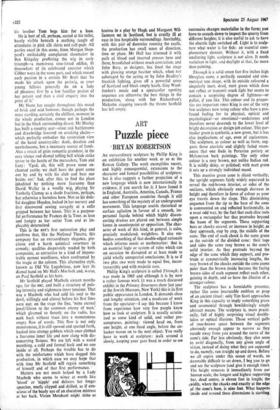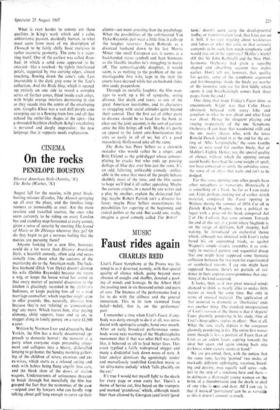Puzzle piece
ART BRYAN ROBERTSON
An extraordinary sculpture by Phillip King is on exhibition for another week or so at the Rowan Gallery. The work exemplifies recent, and highly consequential, extensions to the character and formal possibilities of sculpture; but it also suggests a further projection of a new language which is now internationally in evidence, if you search for it. I have found it in England, Australia, America, Canada, France and other European countries though it still has something of the mystery of an underground movement. This language avoids rhetorical or surface agitation in favour of a smooth, im- personal facade behind which highly discon- certing dramas are played out between simple forms in counterpoint or opposition. The char- acter of work of this kind, in general, is calm, precisely modulated, weightless. It also em- bodies something of that double-edged rationale which informs music or mathematics: that is, an essential logic or system of rules which can on occasion be disrupted or at least made to yield wholly unexpected conclusions. It is as if two plus two were made to equal five, incon- trovertibly and with majestic ease.
Phillip King's sculpture is called Through; it was made in 1965 and although it is by now a rather famous work (it was a much discussed exhibit in the Primary Structures show last year at the Jewish Museum, New York) this is its first public appearance in London. It demands close and lengthy attention, and a modicum of work from the spectator—I say this because I know from experience how very few people know how to look at sculpture. It is usually scrutin- ised as some kind of solid, and rather pre- sumptuous, painting: viewed head on, from one height, at one fixed angle, before the on- looker moves on to the next object. You really have to work at sculpture: walk around it slowly, keeping your gaze fixed in order to see successive changes materialise in the form; you have to crouch down to inspect the quarry from different heights; it is also useful to ask to have the electric light switched off. Light is to sculp- ture what water is for fish: an essential com- plementary element. Without it, with a fixed unaltering light, sculpture is not alive. It needs variation in light, and daylight at that, far more than painting.
Through is a solid seven feet five inches high fibreglass cone, a perfectly rounded and sym- metrical tent shape, with its outside coloured a singularly inert, dead, matt green which does not reflect or transmit much light but seems to contain a surprising degree of lightness—or pallor, if you like. This colour and its proper- ties are important since King is one of the very few sculptors now using colour who have a pro- found feeling for its physical, optical and psychological—or emotional—undertones and therefore never descends to the lower level of bright decoration or design-job colour. This par- ticular green is synthetic, a new green, but it has also implications of age, even of ancientness. The sculpture, as colour as well as form, sug- gests those atavistic and slightly faded reson- ances that one finds in Peruvian pottery or Melanesian bark paintings. The only other colour is a rosy brown, not unlike Indian red. It is mildly_ shiny, or polished; with matt green it sets up a strongly individual mood.
This massive green cone is sliced vertically; the upright segments fairly widely separated to reveal the red-brown interior, or sides of the sections, which obviously enough decrease in height and therefore in force of colour as your eye travels down the slope. This diminishing sequence from the tip to the base of the cone is commented on and reflected horizontally, in a most odd way, by the fact that each slice rests upon a rectangular bar that protrudes beyond the bases of the segments. These supporting bars or chocks ascend, or increase in height, as - they approach, step by step, the middle of the cone. The end of each chock is the same green as the outside of the divided cone: their tops and sides the same rosy brown as the cone's solid interior. As they protrude beyond the edge of the cone which they support, and pro- trude at symmetrically increasing lengths, the rosy brown of the chocks outside the cone seems paler than the brown inside because the facing brown sides of each segment reflect each other, gaining in depth, and so have the illusion of a stronger colour.
The sculpture has a formidable presence, rather like some inscrutable emblem or prop of an ancient ritual : only Tim Scott approaches King in this capacity to imply something grave and ceremOnial through bewilderingly simple abstract means. The sculpture is, more practi- cally, full of highly surprising visual double- takes or optical illusions. Those vertical gulfs of rose-brown space between the segments obviously enough appear to narrow as they recede away from you around the curve of the cone's side. Far less obviously, they also seem to swirl diagonally, from any given angle of vision, instead of doing what they are supposed to do, namely, run straight up and down. Before we all expire under this ocean of words, so damnably difficult to set down, I beg you to go and see the sculpture (and give it enough time). The height removes it immediately from our human scale; the longest and highest supporting bar, dead centre, is eleven feet in length; the ,width, where the chocks end exactly at the edge of the cone's base, is nine feet. What happens inside and around these dimensions is startling. What is even harder to convey are those qualities in King's work which add a calm, unhistrionic passion, decidedly human, to what must seem from most of my description of Through to be fairly chilly basic exercises in rather eccentric geometry. The cone is a recur- ring motif. One of the earliest was called Rose- bud, in which a solid cone appeared to be encased—like a rosebud—by tightly interleaved petals, suggested by two curving edges, almost touching, flowing down the cone's side. Less inscrutable is the dark grey cone in the Tate's collection, And the Birds Sing, which is opened up entirely on one side to reveal a complex series of further cones, fitted inside each other, with bright orange interiors decreasing in size as they recede into the centre of the enveloping tent. Genghis Khan was a vast dull purple cone sweeping out to a flowing train fore and aft that echoed the antler-like shapes at the apex—like a shrouded Scythian chieftain. King's vocabulary is personal and deeply impressive: the new language that it supports needs explanation.































 Previous page
Previous page